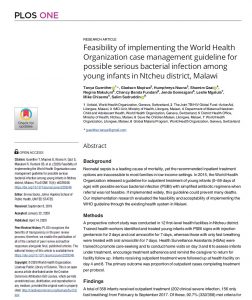
Background
Neonatal sepsis is a leading cause of mortality, yet the recommended inpatient treatment options are inaccessible to most families in low-income settings. In 2015, the World Health Organization released a guideline for outpatient treatment of young infants (0–59 days of age) with possible serious bacterial infection (PSBI) with simplified antibiotic regimens when referral was not feasible. If implemented widely, this guideline could prevent many deaths. Our implementation research evaluated the feasibility and acceptability of implementing the WHO guideline through the existing health system in Malawi.
Methods
A prospective cohort study was conducted in 12 first-level health facilities in Ntcheu district. Trained health workers identified and treated young infants with PSBI signs with injection gentamicin for 2 days and oral amoxicillin for 7 days, whereas those with only fast breathing were treated with oral amoxicillin for 7 days. Health Surveillance Assistants (HSAs) were trained to promote care-seeking and to conduct home visits on day 3 and 6 to assess infants under treatment, encourage treatment adherence and remind the caregiver to return for facility follow up. Infants receiving outpatient treatment were followed up at health facility on day 4 and 8. The primary outcome was proportion of outpatient cases completing treatment per protocol.
Findings
A total of 358 infants received outpatient treatment (202 clinical severe infection, 156 only fast breathing) from February to September 2017. Of these, 92.7% (332/358) met criteria for treatment completion and 88.8% (318/358) completed the day 4 follow-up. Twelve (3.4%) young infants clinically failed treatment with no reported deaths in those treated at outpatient level. This treatment failure rate was lower than those reported for the simplified regimens tested in the SATT (8–10%) and AFRINEST (5–8%) equivalency trials. More than half of infants (58.1%; 208/358) received HSA follow-up visits on days 3 and 6.